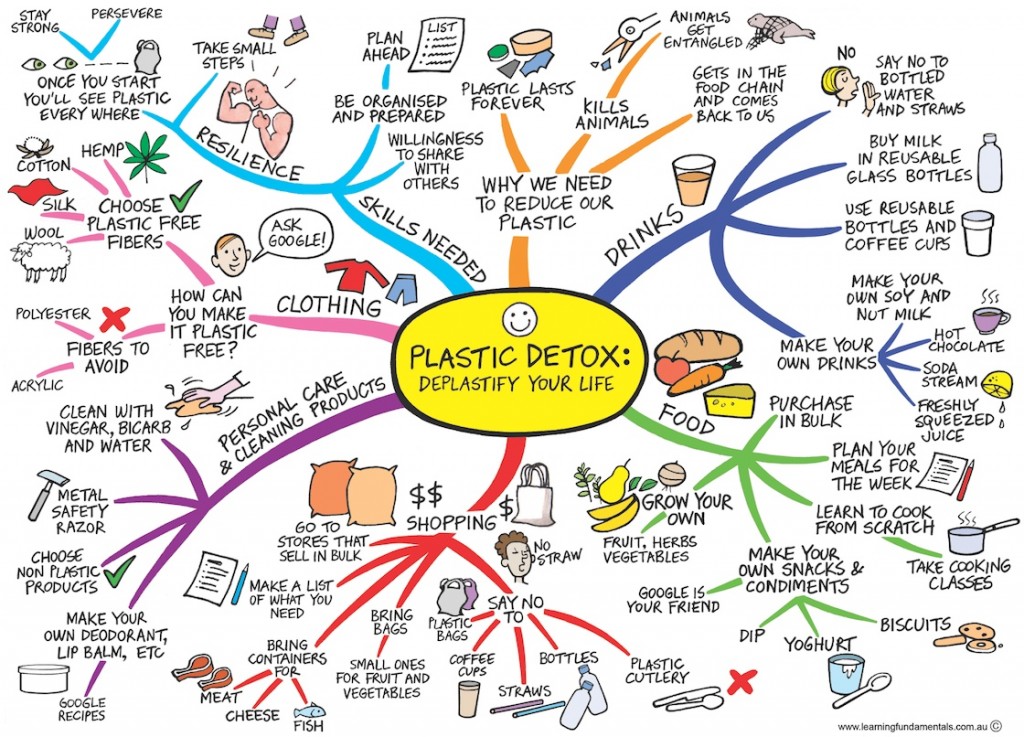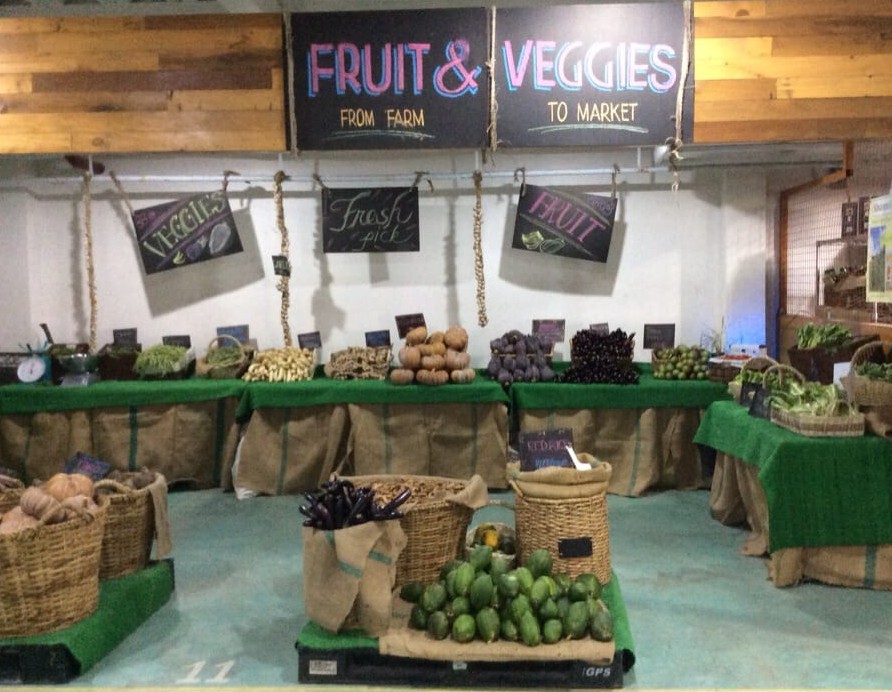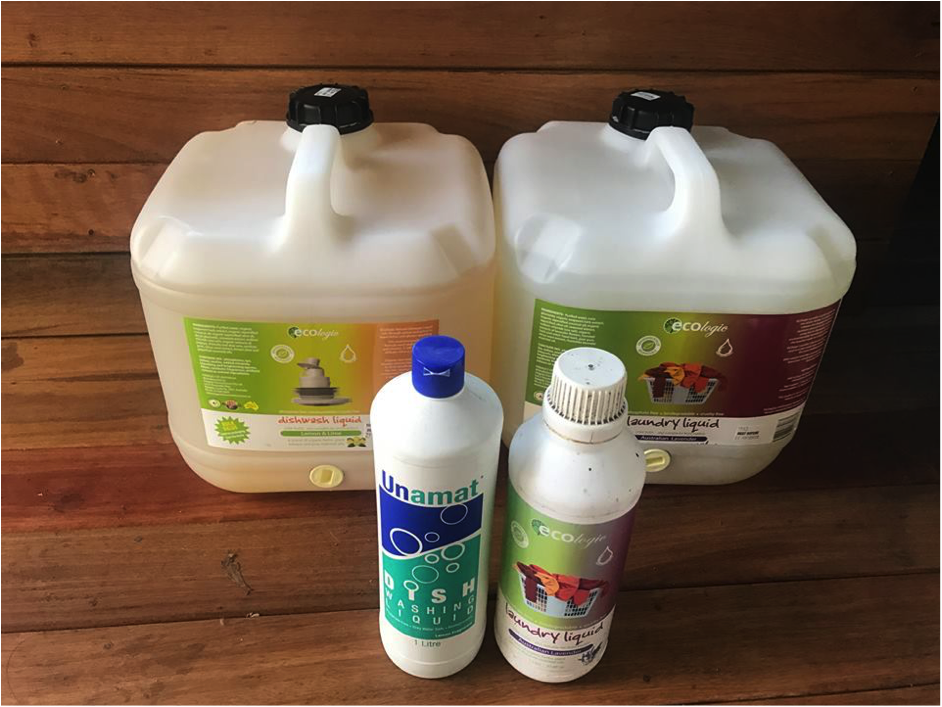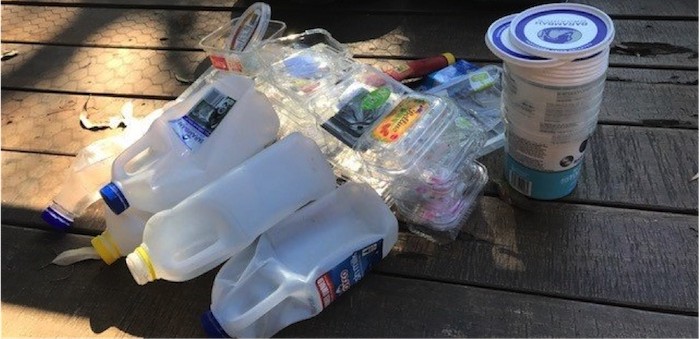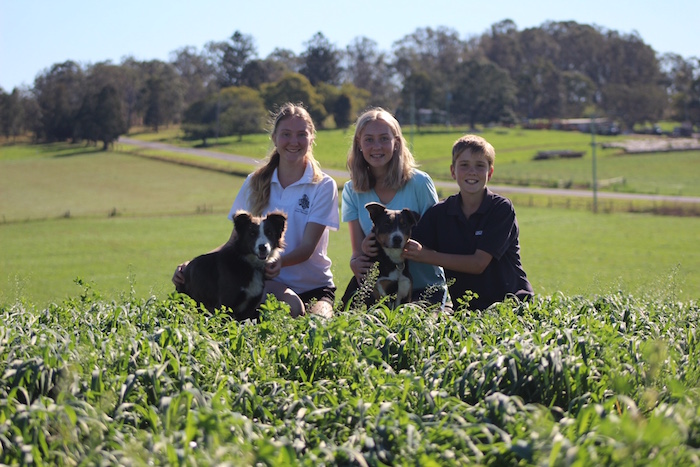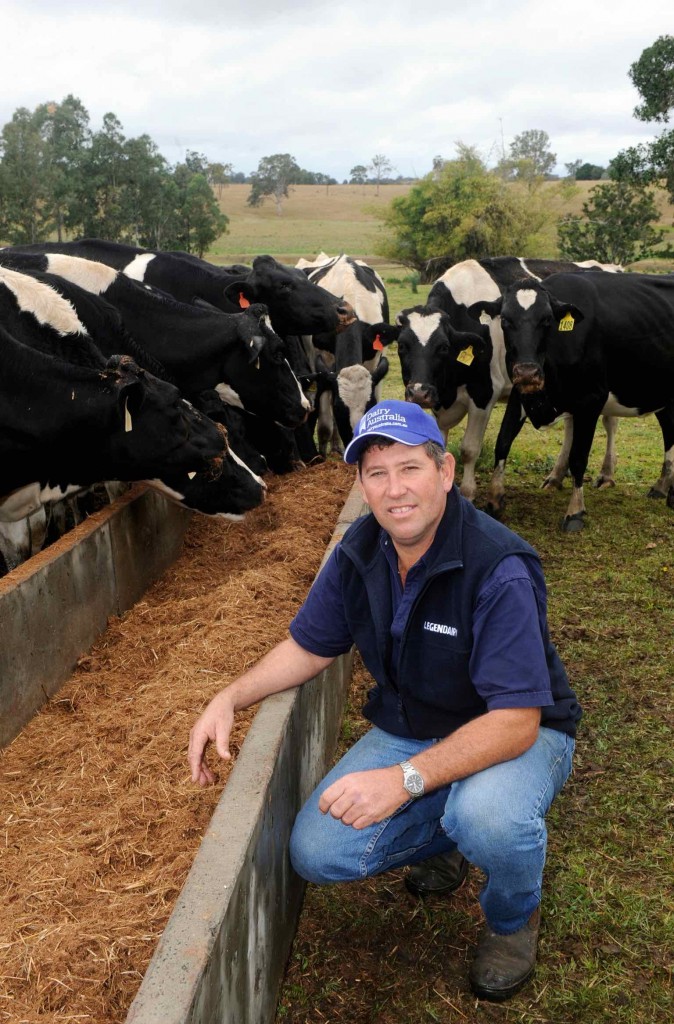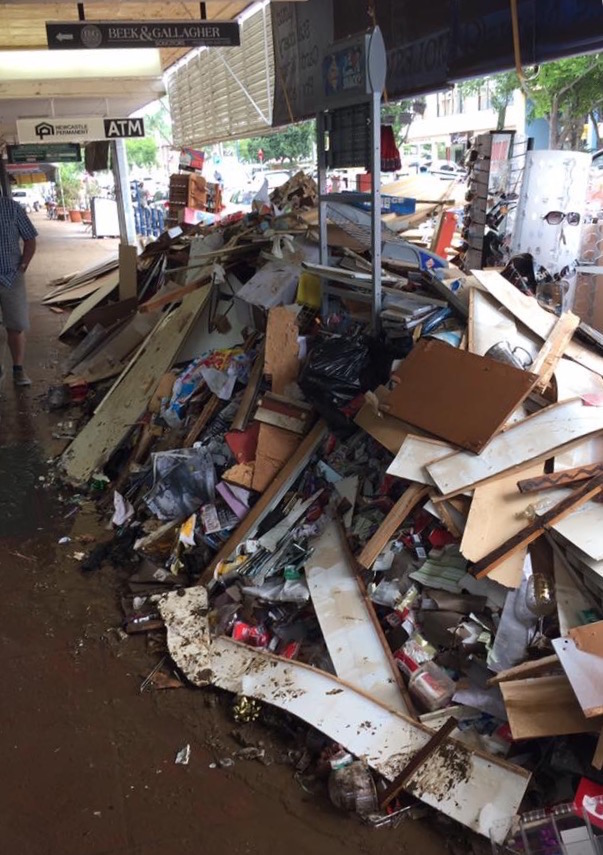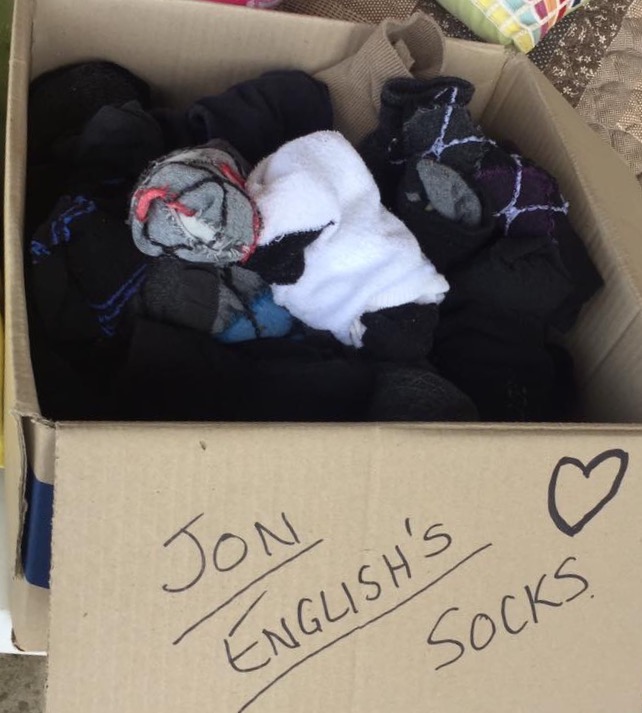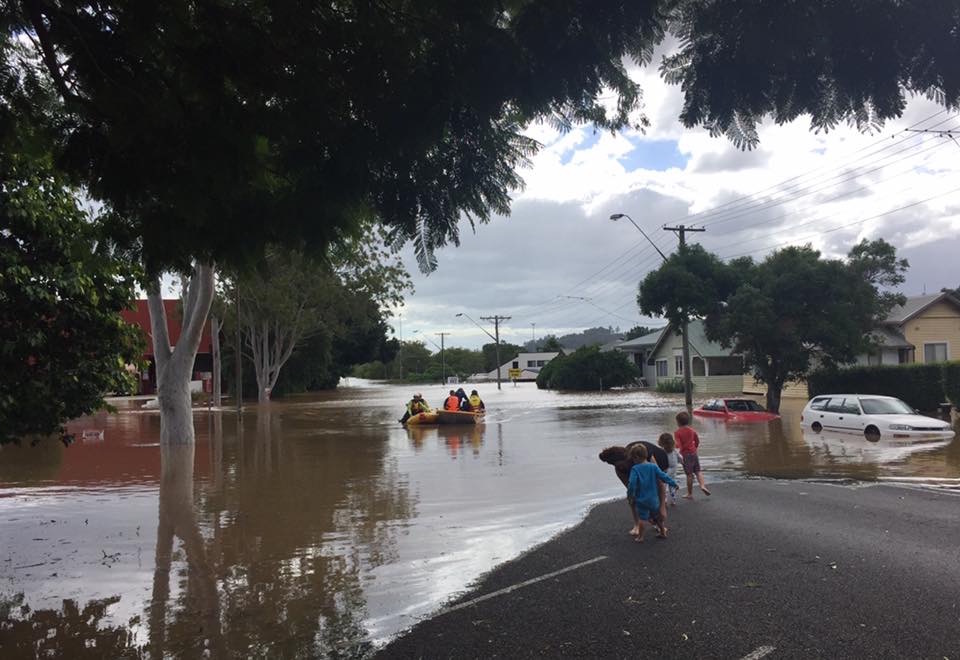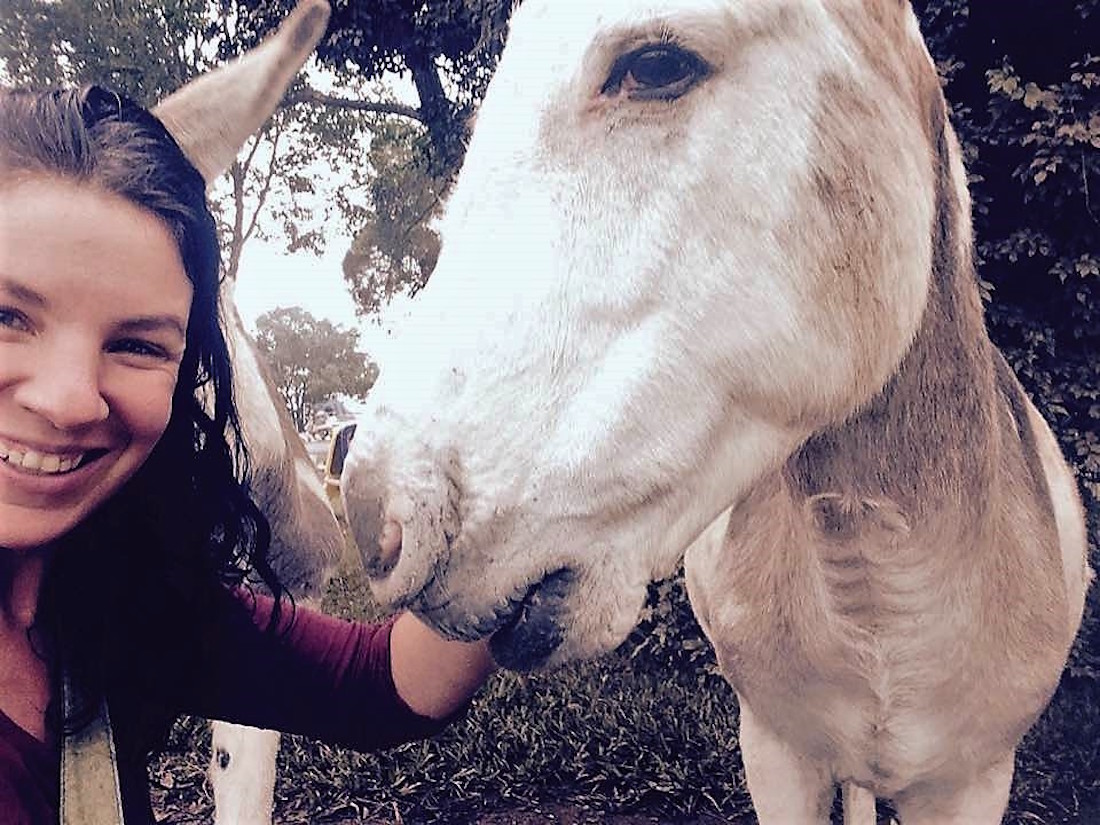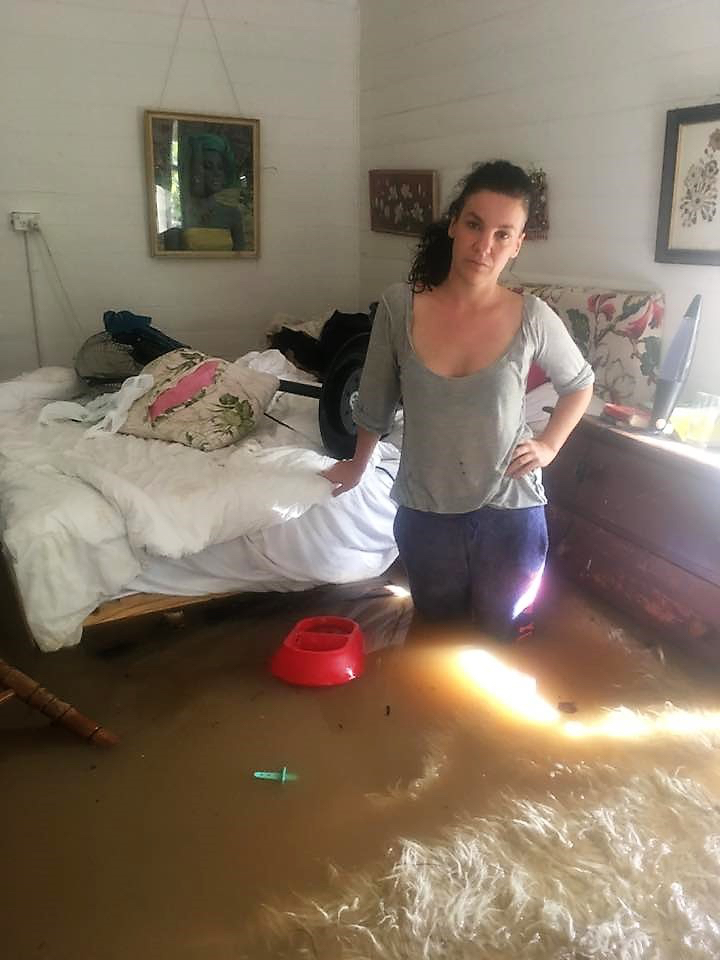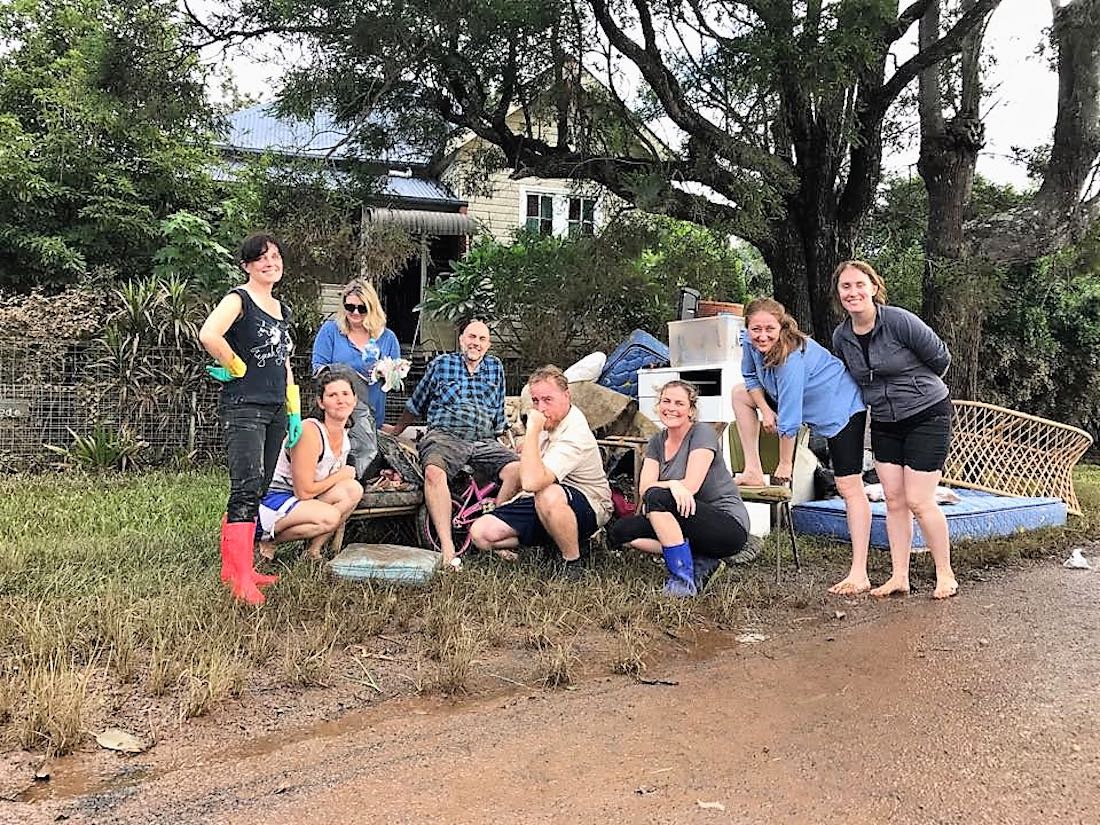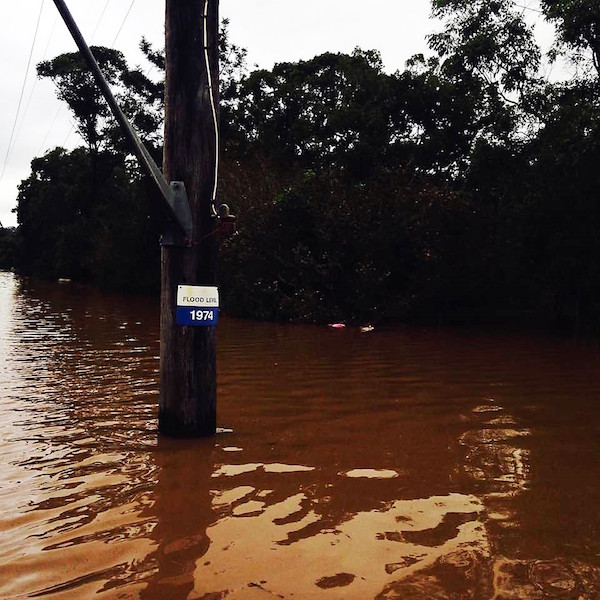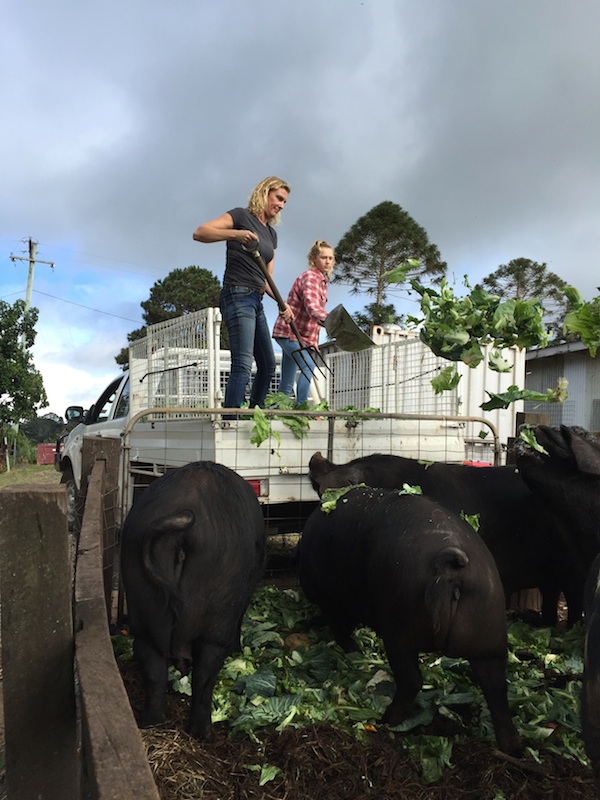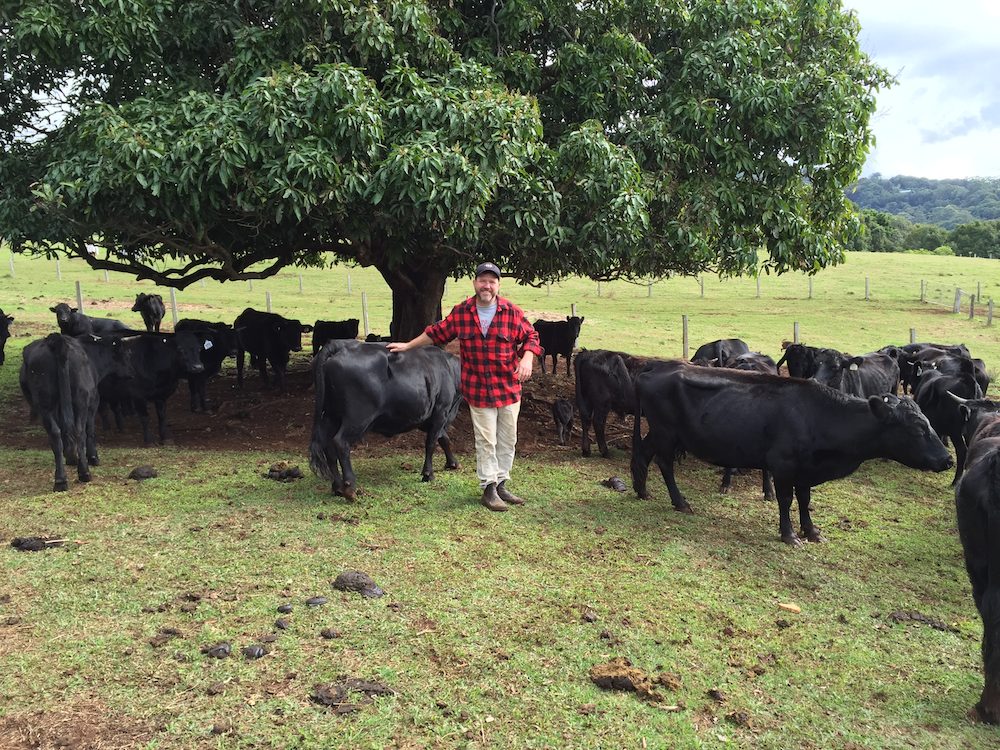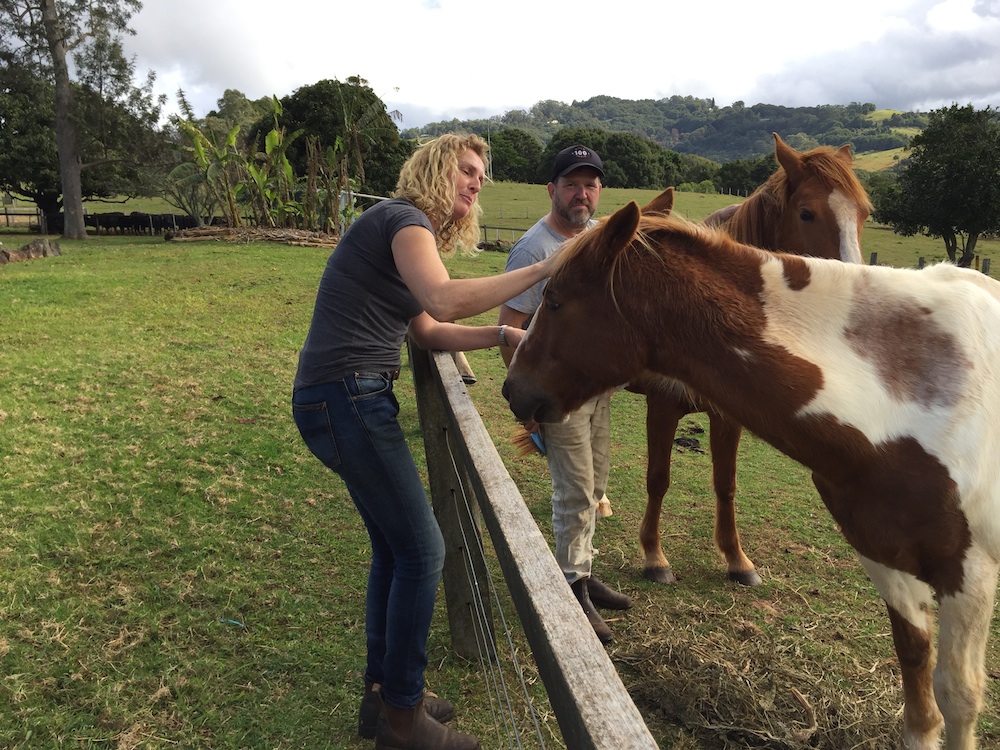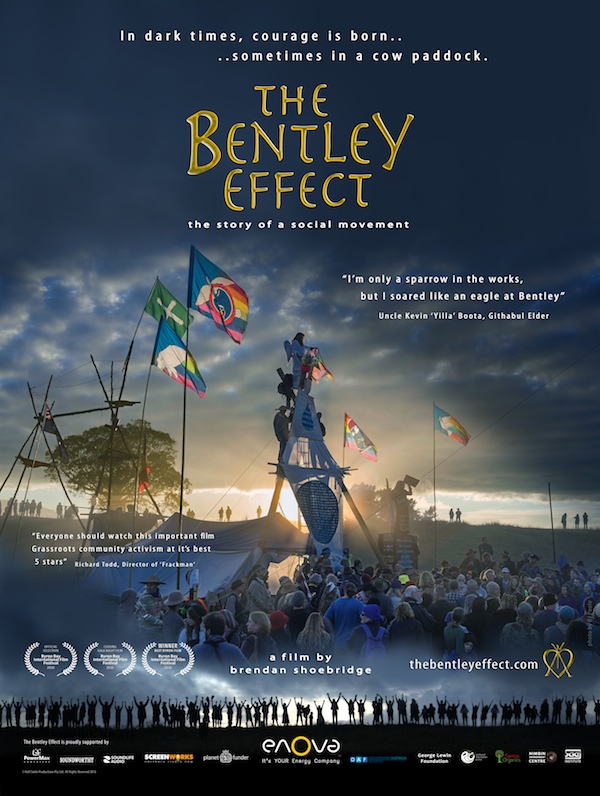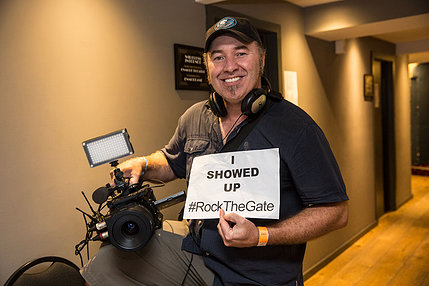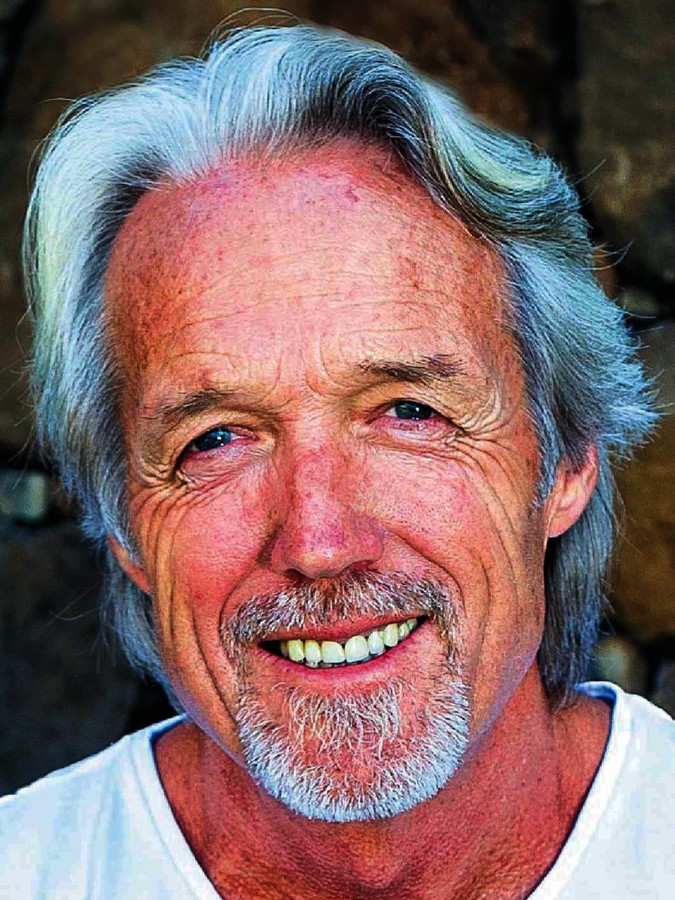The post Myall Creek Massacre Remembered appeared first on .
]]>“I was honoured to be at the Myall Creek Memorial,” says Alex. “Around 500 people gathered at Myall Creek near Bingara to commemorate the 180th anniversary of the massacre that took place in 1838. While there were many many massacres during the frontier wars, Myall Creek was significant in that it was the first time that Europeans were brought to justice for the killing of Aboriginal people in Australia’s history.”
Bingara is a small town on the Gwydir River in Murchison County in the New England region of New South Wales and to mark the occasion a traditional possum cloak was created. “It was displayed at the ceremony,” says Alex, “and it was extremely powerful.”

Carol Sparks, deputy mayor of Glen Innes Severn Shire; Jasmine Knight-Smith and Adele Chapman-Burgess, member of the Myall Creek Memorial committee with the possum skin cloak. Photo: Alex Clarke.
In the past some tribes traditionally wrapped their babies in possum skins. As the children grew more skins were added and decorated with personal stories and connections to country. (Somewhat ironically, the 30 possum skins used for the Myall Creek Memorial gathering cloak had to be imported from New Zealand as it is illegal to kill possums in Australia.) The song-lines on the cloak fan out to represent the song-lines from Boggabilla at the border to Glen Innes in the New England tableands – one of the travelling routes of the Aborigines killed in the massacre. It also features stories of people such as Adele Chapman-Burgess, a member of the National Friends of the Myall Creek Memorial, and one of the artists who helped create the cloak.

Aunty Sue Blacklock, Kamilaroi elder and descendent of the Myall Creek Massacre survivors. Photo: Alex Clarke.
“We won’t forget but we will forgive, and walk down that path together,” said Aunty Sue Blacklock, who can trace her history back to survivors of the massacre. Invited to visit the Myall Creek Station, she’d found it still to hold powerful memories. “If you stood on one place, to me it’s like I could hear the screams,” she said. “It was very quiet, there was no noise, It was just like the wind was bringing their screams as it blew, I could feel their hurt.”
“It was an extraordinary experience to be at the ceremony,” says Alex, whose photographs are a moving testament to the day.







Visitors to the anniversary included Walt Secord, Shadow Minister for Health, Shadow Minister for the Arts, and Shadow Minister for the North Coast, Deputy Leader of the Opposition in the Legislative Council, who announned Labor’s promise of $3 million for a cultural museum at the site of the Myall Creek Memorial should Labor be elected.
The post Myall Creek Massacre Remembered appeared first on .
]]>The post Hanabeth Luke on the problems of going plastic-free appeared first on .
]]>My main question is – why on earth did it take humans so long to figure out that plastic was going to be a problem? As kids we used to play with the rubbish that piled up on the Cornish beaches at high tide with the usual childish lack of interest in where it had actually come from. Personally, I’ve noticed the increase in plastic the most during my visits to Bali over the last 35 years. I’ve seen mountains of water bottles on beaches and tropical islands throughout South-East Asia, and I’ve seen plastic rubbish on fire, releasing dioxins and other nasties into the air. I’ve also seen tons of plastic on the beach, or just thrown off a boat. But what did I do? Well, aside from a few hopeless thoughts on the matter, I kept on surfing. Something was clearly wrong, but I didn’t have any idea where to begin to address this issue.
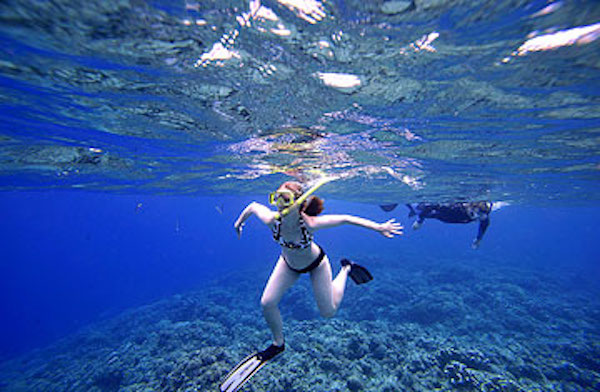
A snorkeller swimming amongst the rubbish in the once-pristine waters of the Bunaken National Marine Park in Indonesia.
Fortunately, the word is finally spreading about the scale of this problem – and, as a lecturer in environmental science, I thought that I had become reasonably aware of the issues, but as I was to find out there was a lot more I could learn.
I teach my students that an estimated eight million tonnes of plastic makes its way into the ocean, every year. I went with a group of students to Bunaken Island, an Indonesian Marine Park off northern Sulawesi, where we could choose from a range of research topics, but really, how could it be anything other than marine debris? On Bunaken, we did some educational games at the local school teaching them about marine waste. Seeing the figures up there in black and white hit me hard – does it really take over 400 years for a single nappy to break down? And what does it ‘break down’ into? Southern Cross Uni students worked with Bunaken high-school students to survey the plastics on their beaches and they found that a common perception was that the waste came from elsewhere. Their assumption had some basis – on the day of our arrival we had watched floodwaters sweep through Manado, bringing a steady stream of plastics floating out to sea. Sure, the cities were a solid source of plastics, and the issue had been exacerbated by the recent flood but our research also identified that a lot of the rubbish we found had been generated by the islanders themselves.
Back home in Australia, I’d swapped my single-use plastic shopping bags for, well, more robust plastic bags. I was trying to think more about it, but still the take-away and yogurt containers continued to form small mountains in my cupboards. A good friend of mine and former colleague, Dave Sharp, had retreated from society, and was walking up and down the East Coast beaches, picking up rubbish and living about as low-impact as a person can. I felt both inspired and ashamed. I pictured Dave picking up the bottles swept in by each high tide and beach barbeque; the abandoned lines and bait bags. It wasn’t easy and it took a huge toll on Dave at times. But although on his own, Dave wasn’t alone. Positive Change for Marine Life are combing the Australian beaches, while Surfers Against Sewage are doing the same in the UK.
Browsing Facebook one day (as you do), the ‘Plastic-Free July’ link popped up somewhere, and thinking this was the perfect opportunity to try harder, I ‘liked’ it, accepted the challenge and decided to share my experiences of going ‘plastic free’. Or at least my attempts to go ‘plastic free’. Even by the end of Day One I’d failed! I was going to a gathering and I was taking guacamole so I wanted to buy corn chips. After agonising over the plastic packets I finally decided to compromise on a half-paper, half-plastic bag. Then I got to the till and cheerfully grabbed a bag of current buns too. It didn’t occur to me until I was in the car that of course the current buns were in a plastic bag. Sheepishly, I posted my first failure, along with the fact that the little bag of corn chips had cost me $8.
It dawned on me that going plastic free was not likely to save me money, and that July was going to be harder than I thought. Following this first post, I received some great encouragement, and some great plastic-free suggestions. I posted a picture of our recycling container on July 1st, which provided a pretty good indicator of what I was going to miss the most (or not be able to avoid). I realised that a number of friends were also going ‘plastic free’, and one suggested I make my own yogurt. I realised that going plastic free was going to take more time. Having just gone on maternity leave, I had no excuse, except that I really really like that brand of yogurt.
I found that Clarence Dairy supplied milk in 750ml glass bottles, which was a relatively easy switch, but it did increase the cost by about a third. With the added complexity of being heavily pregnant, I quickly realised I couldn’t give up my favourite yogurt, which I was going through at lest 250grams a day (and night). The mountain of yogurt containers continued to grow. To quell my guilt, I emailed the dairy company to ask them about the possibility of supplying glass containers, but they never got back to me.
The third of July took me to Aldi for a food shop, and very quickly, I realised that almost everything convenient came wrapped in plastic. This is not limited to Aldi – supermarkets love supplying plastic-wrapped fruit and veg. And while I avoided a lot of plastic-wrapped treats, I still managed to find several plastic surprises once I’d opened the outer cardboard box.
The next shops I went to were PJ’s veggie shop and Pacific Bulk Foods in Lismore, and at last found myself among plastic-free friends. When we asked, they sold us cherry tomatoes in a paper bag, which I was extremely happy about. For raspberries and blueberries (another pregnancy staple), this was not so easy. Although I was among plastic-free friends at the bulk-food shop I still had to be organised, bringing my own containers for any liquids – fortunately another great use for my mountain of yogurt containers. We’d previously bought a large container of laundry liquid, which we’d nearly used up after almost two years, so I invested in a new one, and also 30 litres of dish-washing liquid. It wasn’t a small investment! Returning home, my husband commented that the 30L containers were still made of plastic, but I calculated this was still better than 30 1L containers, and I’m hoping to be able to swap or refill next time. I went home without any toothpaste as well because it was all in plastic tubes.
I was also becoming aware of all the plastics I’d barely noticed before, such as the stickers on apples, washing up sponges, microfibres on clothing, labels on tea bags, microbeads in my facewash. The beach, in particular, appears to be a magnet for poor quality products. Many are not much better than single use, such as crappy beach umbrellas just waiting for one good gust to put them out of action; cheap plastic camping chairs guaranteed to last one holiday – if you’re lucky – polystyrene bodyboards and all the plastic that a good picnic requires.
The plastic-filled universe around me seemed to expand with my own awareness! it On my birthday I decided to celebrate by going to the Bay FM 80’s disco – I was less than a month away from my baby’s due date, so this would be my last chance to boogie for a long time. It was a lot of fun, but it was also a plastic blow-out, with soft-drinks and water all served in a plastic cup. I nagged the organisers and realised how important it is for plastic-free ideas to permeate events like this. Then we had a last dash baby-free stay with friends at Moonee Beach, which was mostly easy due to the large proportion of wholesome and delicious home- grown meals, however we still forgot/failed to avoid plastic in fish n’chips sauce containers, and when I wasn’t looking, Hubby bought a case of Kilkenny wrapped in plastic.
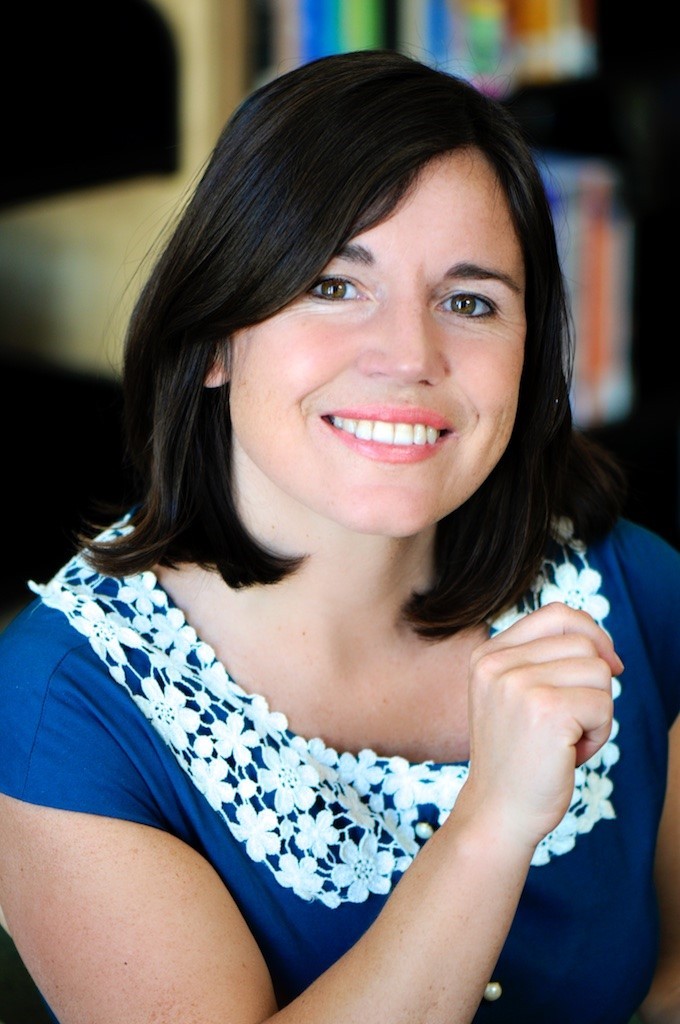
Dr Hanabeth Luke; Associate Lecturer, School of Environment, Science and Engineering, Southern Cross University.
We went to the movies to watch Wonder Woman, and the popcorn and jumbo juice came in cardboard looking containers which were, I suspect, plastic lined. This was when I discovered that NSW regs dictate the plastic lid to be mandatory so I avoided the straw at least. Travelling home on the Pacific Highway, my son’s emergency sausage roll came in plastic, with a plastic tomato sauce, containing more plastic than sauce. Once more convenience won over the planet.
During a weekend in Byron, I avoided the use of at least three disposable coffee cups due to the purchase of a nice new glass ‘keep cup’, but bought a yogurt meal pre-made in plastic cup (bloody yogurt again). Solution? It’s all – or mostly – avoidable with better organisation. At this point we decided to keep a picnic basket in the car with eating-out containers, cups and cutlery. And our own tomato sauce.
Another plastic-free blow out came on 22nd of July, along with the joyous arrival of our baby girl. Despite my extreme hunger at my post-birth breakfast, I couldn’t help noticing that everything was wrapped in plastic. I thought of all the little trays throughout the hospital, at all the hospitals in Australia. The health system: another institution that could seriously cut down its plastic use. Another admission I have to make was my online baby item purchases, most of which came wrapped in a decent amount of plastic. I hadn’t previously noticed that Australia Post had at some point switched to all plastic envelopes.
While one plastic-free breakthrough for us was that we finally toilet-trained our boy during July, thank goodness, that didn’t fix the bigger conundrum for our new baby. While we’ve been using cloth nappies for our newborn, with our first kid we noticed that nights were so much better when we weren’t needing to change wet cloth nappies at night: one disposable nappy and you’re set. Plus, you avoid the daily need for washing, including the energy and water involved. We reconciled by using a high-quality compostable brand, Naty, which is almost completely compostable except for the velcro tags. As time went on we replaced the cloth nappies all together. Except, what do you actually do with the compostable nappies, in reality? Well they stink, so you wrap them in plastic if there’s no compostable bags around. You can’t put them in your own compost because there’s too many of them, and you can’t put them in the Green Waste bin because the tip workers would hate you when they went through the chipper. So (sigh), they end up in landfill. There’s a bit of guilt relief with the knowledge that they won’t sit there for 450 years, but surely there’s a research/business opportunity right there. Babies go through a lot of nappies. A very dry winter left us with little water, so the daily wash required for washable nappies became a little untenable. We did manage to switch from disposable wipes to a reusable washer, and that was surprisingly easy – and we’ve also been inspired to plant a small veggie patch.
Since July, I’ve become more aware of a whole new range of biodegradable products such as bamboo hair brushes and vegetable-based kitchen scrubbers, and beeswax covers to replace cling film (I’m going to make that purchase RIGHT NOW!). I noticed that SCU are now giving out bamboo USBs to students. People are pioneering plastic replacements made from shrimp shells; developing biodegradable boat paint; and the Five Oceans crew are making surfboard fins out of Indonesian ocean plastics. A Norwegian billionaire agreed to fund the world’s largest yacht to scoop up marine plastic. There are endless opportunities to go plastic-free, including plastic-free picnics, business meetings, conferences, parties and festivals. I know there are people working hard in many of these areas, but this is just the beginning.
As July came to an end, I pulled our plastic waste out of the recycling bin and weighed it, with yogurt containers, along with the blueberry, strawberry & raspberry packets, making up a significant portion of 750 grams of our hard plastics. Once again seeking to relieve my guilt (while creating a movement of consumer demand), I contacted five different berry companies about their packaging, receiving a response from only Driscolls, who had tried other options, but had settled for using grade one recyclable plastic to keep the berries fresh. Perhaps berry packets would be a good use for the new plastics being developed from shrimp shells? I hope that the berry companies and many others will revisit their plastic use sooner rather than later.
Over one million people from 159 countries registered and took part in Plastic Free July. The experience provided me with the opportunity to discover and share some awesome plastic-free ideas and initiatives. It was really good for setting up some basic habits to reduce my family’s plastic waste, but it also made me aware of the balance between convenience and plastic. I wish I could say I was ‘plastic free’, but really we still consumed quite a lot of products that were packaged or posted in plastic. Eating on the run was a challenge but we became more organised and had some lovely picnics. I absolutely acknowledge that the extra time I had being on maternity leave allowed me more time to even think more deeply about this, let alone take the little extra time needed to plan better and make better choices.
Unfortunately, on a global scale there is still a long way to go, with companies such as Coca Cola producing about one million plastic bags each minute, of which only about 9% are recycled. It’s mind boggling. I’ve said for a long time many big companies could change things for the better, astonishingly fast, if they chose to. But nevertheless around the globe, I see hope: Costa Rica plans to be the first country to ban all single use plastics by 2021; while France has passed a law to ensure all plastic cups, cutlery and plates are made of biologically-sourced materials which can be composted by 2020; India is banning all disposable plastic in Delhi, its capital city. In July this year, the UK government announced that it was banning microbeads, another insidious plastic in our sunscreens and beauty products. Back at home, Woolworths and Coles agreed during this July to phase out single-use plastic-bags in New South Wales, Victoria and Western Australia, a big win with Queensland Woolies the final State planning to make the shift in 2018.
I strongly believe that our personal consumptive choices do make a difference: we vote with our wallets and our daily purchases. Whether we like it or not, we’re as guilty of generating plastic as anyone in the world. While we may be only just embarking on the plastic-free road, I feel confident that this is an environmental issue that we have every opportunity to turn around.
The post Hanabeth Luke on the problems of going plastic-free appeared first on .
]]>The post A’Laya – from soil to soulful skincare appeared first on .
]]>It’s odd to think about it now, but it’s not really that long ago since my mother’s generation lay out in the sun for days without any sun protection – just hanging for a good tan. My generation, of course, grew up with hats and sunscreen. The Slip, Slop, Slap campaign, and our parents’ mistakes, taught us some valuable lessons about the importance of quality skincare.
As the driest continent in the world, with some of the highest UV rays and skin cancer rates to boot, we are unsurprisingly home to some of the best skincare products available on earth. Adding to these amazing products is not an easy task, but we think we’re onto something really special and we’re going to be looking to our local community to help us share it with the world.
A’Laya Super Skincare is locally grown, formulated and processed in the heart of the Byron Bay hinterland on a family farm that’s been quietly supplying medicinal herbs to our community for over 15 years.
Our Super Skincare secret lives in our farm to face equation, which reduces the uncertainty of quality supplies, as well as our unique alchemical combinations; a synergy of superfoods, superherbs and organic botanicals that has naturopaths, ayurvedic doctors and herbalists impressed (as well as us).
Community is lifeblood and “collaboration is the essence of life. The wind, bees and flowers work together, to spread the pollen and we collect the berries.”
― Amit Ray, Mindfulness Living in the Moment – Living in the Breath
When I was at uni studying Environmental Policy, Vandana Shiva’s Earth Democracy Movement and Anita Roddick’s work pioneering Corporate Social Responsibility and the Kindness Revolution were huge influences on me. And while environmental policies are yet to catch up, I continue to think that each of us can play an important part in protecting our environment, both in our personal lives and in our businesses as well.

Angela Rowland and Tino are launching a crowd fundraiser for their new local skincare range, A’Laya Super Skincare.
Both my business partner, Tino, and I grew up locally as school friends, and we were both instilled with a great desire to preserve biodiversity and foster local innovation and employment. Add to that the recent birth of Tino’s first daughter, Alaya, after whom our skincare range is named, plus my passion for sustainable agriculture and wellbeing and our collaboration was born. Tino wants to leave his daughter the finest and most sustainable skincare available, made from the superfoods and medicinal herbs that he personally grows and processes, much like his father has gifted him with a legacy of farming and knowledge of herbal medicine.
I want to infuse each ingredient with love and a blessing that all people will live naturally happy and free lives, without interference from unnecessary chemicals and artificial preservatives – to nourish their skin and soul.
We are trying to follow a model that is quadruple bottom line: beneficial to the earth, caring and inclusive of all people, as well as nurturing for our community, our culture and our spiritual wellbeing.
Alaya are launching their Indigogo crowdfunding campaign on September 7. Share their story with your friends and make a pledge to get your hands on our unique, hand-made local products at a ‘reward’ special pre-launch price as a thank you for helping them.
Go to: alayaskin.com
The post A’Laya – from soil to soulful skincare appeared first on .
]]>The post Bamboo bedding for the sweetest of dreams appeared first on .
]]>Are you struggling to catch those restful eight hours of sleep? With our increasingly busy lives and everyday stresses, a peaceful night’s rest at the end of the day seems more like a theory than a practice. But that ever-elusive rest is now a reality, with Metisa Bamboo and their 100% Organic Bamboo bed sheets & quilt covers range.
Sonia Tribe, from Natures Linen, advises organic bamboo textile is a healthy option to many other fabrics which can irritate the skin or cause allergies to flare up. “Metisa Bamboo sheets are perfect for people who suffer from allergies or skin conditions, the bamboo sheets are hypoallergenic and antibacterial, and are especially helpful if you suffer from lung and respiratory problems,” she says. “These sheets repel dust and dust mites”.
“The best thing about bamboo is that it is such a sustainable and versatile resource,” says Sonia. “It provides many different benefits because the bamboo functions as a carbon sink, produces oxygen, and controls soil erosion. Bamboo grows in virtually any climate and doesn’t require the use of fertiliser or pesticides to grow which in turn helps eliminate or reduce the amount of chemicals we are introducing to the earth which means we are able to help sustain the valuable nutrients already present in the soil.”
Sonia is a firm believer in giving back to the earth. “We want Natures Linen to be a leader in sustainable, environmentally friendly products,” she says.
So if you want to buy local go to Natures Linen and view their range of Metisa Bamboo products.
- Natures Linen have partnered with Afterpay so that you can shop now, pay later, receive your items now and pay off your purchase over four weeks, with no interest and no fees to pay.
- The company accepts all major credit cards and PayPal
- Subscribe to their newsletter and receive 10% off everything you purchase in your first order
- All orders over $150 include free shipping
The post Bamboo bedding for the sweetest of dreams appeared first on .
]]>The post Seeing a vision for Padua Park appeared first on .
]]>James Toohey’s wife Rose-Anne described the undulating country they’d gone to inspect, running creek and with Scotch thistles on it to her husband and he knew, beyond doubt, it would make a good farm.
They selected the country and named it Padua Park, cleared it for farming and now110 years later their great-grandson Terry Toohey continues to enjoy its benefits.
James was 37 when he purchased the land and the thistles were a deciding factor. “There’s an old-time saying that Scotch thistles only grow in good country, so they selected this area and developed it,” Terry says. “He was totally blind but managed to keep farming. How they did it with what they had in those days was a mighty feat.”
The farm, 10 kilometres west of Casino has expanded over the years to 160 hectares where Terry and his wife Annabelle and their children Hannah 18, Lily,15 and Jacob 12, milk 300 Holstein cows.
Padua Park has some notable history; it was the first farm in the region with a tractor and the farm-house was once partially destroyed by a mini tornado. Fourth generation Terry says he “wouldn’t swap it for the world”. Terry spent more than a decade as a stock and station agent but was keen to return to the land. “I wanted to work for myself and give my family the same opportunity to experience the rural life that I had,” he says.
Terry became involved in farming representation about 12 years ago. He was on the Australian Dairy Farmers board and its animal health and welfare group. He chaired a cross commodity board for the National Farmers Federation, joined the Cattle Council of Australia, was on ministerial-appointed agriculture boards, and is Dairy Connect’s Farmers’ Group Representative.
“Dairy Connect came about because dairy farmers wanted united representation just for their interests,” he says. “We’re now the only organisation in Australia with a paddock-to-plate board including processor representatives and the grocery/retail sector.” Now in his late 40s, Terry places a strong emphasis on planning for the future using technology and innovation.
“We’ve got to think outside the square and develop policies for the younger generation,” he says. He wants to maintain a collective bargaining group with his processor Parmalat, and is pushing for the value of milk to be maintained on the domestic market. Terry sees a bright future for the industry in northern New South Wales, particularly as people move to the region for lifestyle reasons. “New South Wales is one of the most profitable dairy industries in Australia.” He supports the concept of Legendairy to raise the profile and reputation of the dairy industry and thinks people are responding. “Consumers voted against $1 milk and instead purchased private label milk because they can see the benefits for the farmers,” he says. “People appreciate farmers and didn’t go for the cheapest product.”
“We’ve got to think outside the square and develop policies for the younger generation,” he says. He wants to maintain a collective bargaining group with his processor Parmalat, and is pushing for the value of milk to be maintained on the domestic market. Terry sees a bright future for the industry in northern New South Wales, particularly as people move to the region for lifestyle reasons. “New South Wales is one of the most profitable dairy industries in Australia.” He supports the concept of Legendairy to raise the profile and reputation of the dairy industry and thinks people are responding. “Consumers voted against $1 milk and instead purchased private label milk because they can see the benefits for the farmers,” he says. “People appreciate farmers and didn’t go for the cheapest product.”
“We’ve got to think outside the square and develop policies for the younger generation,” he says. He wants to maintain a collective bargaining group with his processor Parmalat, and is pushing for the value of milk to be maintained on the domestic market. Terry sees a bright future for the industry in northern New South Wales, particularly as people move to the region for lifestyle reasons. “New South Wales is one of the most profitable dairy industries in Australia.” He supports the concept of Legendairy to raise the profile and reputation of the dairy industry and thinks people are responding. “Consumers voted against $1 milk and instead purchased private label milk because they can see the benefits for the farmers,” he says. “People appreciate farmers and didn’t go for the cheapest product.”
Terry also hopes to get agriculture back on the school curriculum and is involved with Dairy Australia’s Cows Create Careers program in Casino’s public school.
For more Legendairy stories, head to www.legendairy.com.au
The post Seeing a vision for Padua Park appeared first on .
]]>The post Jenny Dowell on life after Debbie’s departure appeared first on .
]]>I’d always said to friends in Melbourne that if Goonellabah flooded it was time to build an ark! Well, we had water throughout our living area when the drains failed to cope with the 400mm that fell in 24 hours. But that was trivial compared to the mess that Debbie left when she finally departed. The Wilsons River reached 11.6m – close to the 1974 big flood and the 10.6m levee was overtopped, as we always knew it would be when the inevitable big flood came.
When the flood waters receded and all of us got down to work, cleaning, laundry and door knocking to check on people’s welfare, I heard my fair share of distressing stories but even when people had lost most of their possessions, there was a general response “I’m OK, there are people much worse off than me”.
Through the tears there were often smiles and hugs as people connected like never before. The Lismore Come to the Heart symbol has always been more than a marketing logo. Many of us have worn the little heart badge as a sign of pride that we live in Lismore but after this flood event, the Heart has become a symbol of rebuilding and connection to each other. When the Black Sombrero in the CBD hung a Heart flag on its door to indicate it was reopening, requests came for more, so sewing bees were arranged at the Black Sombrero for these flags to be produced for other businesses as they reopened.
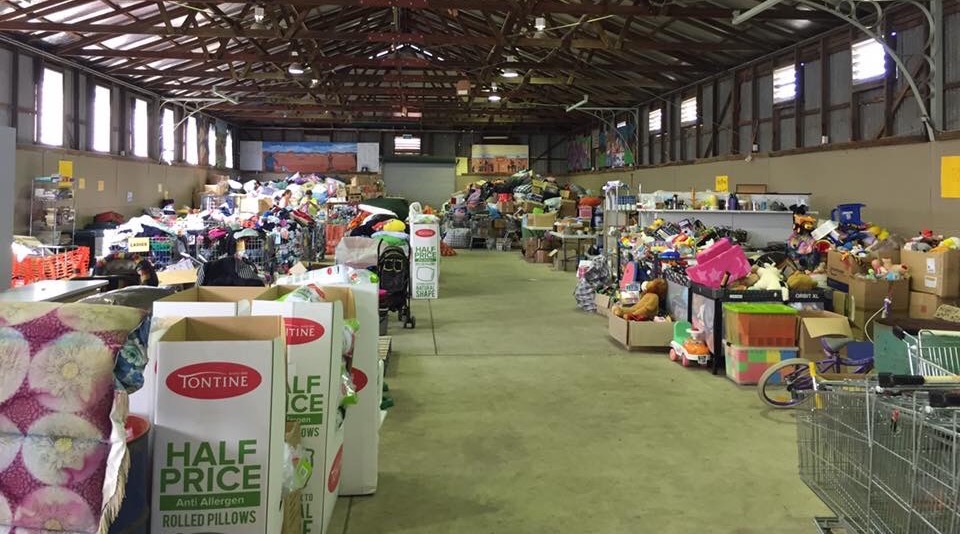
Lifeline NR set up in the Pavilion at Lismore Showgrounds to help people affected by the flood by distributing donated goods.
The heart badge became a sign of determination and resilience and council has noted a steady stream of residents buying the badges to wear and give to others to lift their spirits.
The stories of loss and grief will continue for many weeks and months and even longer for some but this community is strong and connected with someone always at hand to bear the load when things get too hard.
Thousands of people evacuated and while much of the contents of homes and businesses was secured and lifted, the height of the flood and the force of the water was greater than most people expected. As readers will have seen, the damage to homes and businesses in the CBD, North and South Lismore and parts of East Lismore was immense with thousands of tonnes of damaged goods piled up on footpaths as the recovery commenced.
The good thing – from every disaster, the strength of the community is demonstrated in the very difficult and long recovery stage after the emergency has passed.
An army of volunteers mobilised through Lismore Helping Hands Facebook page to attend thousands of homes and businesses. These volunteers helped clean premises and provide essential material aid and food to the people affected. Hundreds of RFS and SES volunteers from around the state provided much of the heavy lifting and high pressure hoses to help clean out buildings as people tried to salvage important items.
As the emergency passed, the disused Lismore Railway station was a hub for the volunteers to form teams and for people to get food, bedding and clothing. Lifeline’s regional warehouse received tonnes of financed items and just as quickly was distributing goods to affected people. It wasn’t long before it became obvious that the warehouse was simply too small to cope with the supply or demand so a league Pavilion at the Showgrounds became the central collection and distribution centre not just for Lifeline but for many other charity groups.
The official NSW Government sponsored Flood Recovery Centre was also established in East Lismore to provide people with a one-stop-shop for advice on insurance, grants, fair trading, small business, primary industry assistance and more.
People who were unaffected by the disaster flocked to help and shopping in the supermarket in mud spattered clothing and rubber boots didn’t even cause a raised eyebrow, but the emotional toll of the flood was obvious despite the generally positive spirits. In the days after the water had gone, every heavy rain shower brought back feelings of dread. The need for material aid for affected residents was also obvious and the community responded.
Lifeline Northern Rivers warehouse in South Lismore was soon overwhelmed by the sheer volume of donated clothing, furniture and household items so the opening of the Pavilion at the Showgrounds provided not only a much needed large space for donations and distribution but the opportunity for all charities to work together.
The Helping Hands hub remained the centre for donations of non perishable food, willing hands for heavy lifting and cleaning and teams of skilled people to undertake welfare checks in the most vulnerable people until it closed on April 23.
Our council, including Mayor Isaac Smith, has been magnificent as were the emergency services volunteers who came from far and near to help. Among the volunteers who put their own lives on hold to help others, new leaders merged with the temperament and skills to mobilise teams of people who had never worked together before. In my opinion, those leaders – many of them in their early 20s – will be names to note as community leaders of the future.
Three weeks after the flood, there is still much to be done. Hundreds of residents are not back in their homes and some may never be able to return. Many people will continue to need material help, many more will require emotional support and fundraising will continue to be required on top of the welcome financial assistance from government.
It is hoped that the Lismore Helping Hands Facebook page will continue with people linking up to help each other not just in relation to this flood event but for the future.
Volunteers can only do so much and it would be ideal to see an existing larger organisation take on the coordinating role of overseeing the wellbeing of flood-affected people into the longer term. Volunteers will still be needed to contribute a few hours or a day when they can but I think that the overarching coordination requires a paid project officer with the structure of a larger organisation to provide the framework. We cannot let the aftermath of the flood result in a loss of community cohesiveness or wellbeing. That would be an indictment on all of us and a tragedy that we must avoid.
The post Jenny Dowell on life after Debbie’s departure appeared first on .
]]>The post The boat, the boy, the bees and the donkeys – Lismore’s flood appeared first on .
]]>Thursday March 30
Precious resources: Rain gauge wisdom
I woke to the fragrance of big rain. In autumnal North Lismore, this means your pillows smell of mushrooms and loved ones like sourdough gingerbread.
My olfactory system had confirmed the Bureau of Meterology’s prediction: A cold front had indeed interacted with moisture from Tropical Cyclone Debbie.
By 7am a Terania Creek local informed his social media network of an unprecedented 557mm rain gauge reading. The CBD seemed nonplussed, however. It was coffees and smashed avo on toast as usual. It wasn’t until after lunch that the Bureau Meteorology sounded its warning – a major flood was expected overtop the levee at 11m.
After the June 2016 moderate flood that took out North Lismore, council reminded flood-prone Northies of their floor heights in a preparedness pack dated December 1. In the letter, those of us on the wrong side of the levee were informed we would be responsible for our own post-flood roadside waste collection services. I’d lost the file that would have told me my floor height was 11.38 metres. Instead, I cautiously estimated I was sitting at 10.8m, and threw toys, books and linen on beds. Good stuff went into the attic space. The rest of the afternoon was spent heaving white goods up stairs and aiding the elderly on my street.
For the flood-weary North Lismore community, a motley crew of single mums, boho seniors, greyhound trainers, artists and ratbags, floods are a relatively normal part of Lismore Life. We began mobilising well before the BOM warning. Vehicles were moved to higher ground and grog for infamous flood-party booze-ups were stocked.
One CBD bottle shop was clearly in a state of paralysis – still selling beer at 5pm as if they hadn’t got the memo. Surely the stuff on my bed would be fine then, right?
The evacuation text pinged at 5.45pm but I’d already headed for my friend The Captain’s place which was on even lower ground – aptly named Lake Street. The prefect launch for a flood rescue tinny. By 10pm the water was in the yard and it was safe to put the bung in the boat.
Friday March 31
Precious resources: Hindsight and a water vessel
I slept right through the 4am levee overtopping sirens and woke to water close to the 12 metre floor.
Jill, the six-month-old Border Collie chased a snake into the flood water and vanished. The phone started beeping. There was already a list of neighbours to rescue and deliveries to make. With the dog presumed dead, we disentangled palm fronds from the boat motor. Then the puppy’s stupid black and white snout poked out from the canopy. She was pretty pleased with herself and her newfound waterworld. Myself, less so.
After delivering transistor radios, feeding stranded dogs and ferrying families to high ground, I worked up the courage to break into my own place and have a look around (timber doors were warped shut). The stuff on the girls’ beds was under water and my coveted reupholstered deco lounge suite was almost submerged.
Clearly, I decided in a moment of self-pity, I don’t deserve nice things.
We ferried four blind drunk youths with facial tattoos from an industrial roof to Hindmarsh Street. They didn’t thank us.
Saturday, April 1
Precious resource: Friends with squeegees
Cut off from the CBD, hilltop gawkers lapped at the flood’s edge with mobile phones. I had the good fortune of being able to recruit eight wonderful helpers to sluice out my house before the flood mud caked.
It was getting dark and my cavalry of cleaners needed to get home. The roads out were still underwater but the flood tinny’s route had becoming dangerously low. The mission was not helped by a disenfranchised bee colony which decided to rehome just above where the tinny was anchored.
A friend’s bees weren’t so flood prepared, however. I saw a photo of a lifeless box of bees on Facebook. For species with the capability to swarm and relocate with relative ease, the image was morbidly metaphorical.
Why didn’t they swarm? Why didn’t we? Did the Queen not get the BoM warning until it was too late, or had the swarm just become complacent?
Meanwhile, high-and-dry Goonellabah was in panic buying mode. Down in the bayou, cut off, with no power, and undercharged phones, we were giving freezer meat the sniff-test and eating whatever we could before it turned.
Sunday April 2
Precious resources: Dry firewood
The flood water subsided and people returned to homes and business to witness an zombie apocalypse garage sale from hell. I began triaging the streets of North Lismore with a Lismore Base Hospital Emergency Doctor. He was able to unemotionally assess where we were needed most, get them over their crucial heartbreaking hump, and move on to the next neighbourhood nightmare. This is where it really helps to know your neighbourhood. North Lismore knows where the elderly woman with cancer lives. We know where the woman with little bub lives. It’s the sort of triage that state-level emergency services just cannot do. achaten-suisse.com I also got to chuck a lot of soggy mattresses off high-set verandahs which made me feel very rock n roll.
The Rural Fire Service were deployed to hose down homes. The guys from Grafton value-added their service at mine by hosing down the clothes on my washing line and resuscitating my fireplace.
Monday April 3
Precious resources: Centimetres and yards
I got out the measuring tape. If my floor height was really 11.38 and the flood watermark was 70cm over that, then why were authorities stating the flood peaked at 11.6m? The numbers didn’t add up.
Later, I heard a cry from a Lake Street resident. It was 87-year-old Joy Love, born next door. She wanted to know if her husband had pulled through a touch-and-go operation but her phone line was down and she didn’t know how to use a mobile. Mrs Love explained doctors had ‘cut out a yard of poisoned intestines’ from Mr Love. I helped her make the call and she broke down in literal floods of tears. He had pulled through. Suddenly disparities over centimetres of plasterboard fell short of Mr Love’s guts measured in yards.
Tuesday April 4
Precious resource: resilience and Wi-Fi
Perhaps Telstra had a deep-seated a fear of being trolled on Twitter by flood refugees with smartphones, but their disaster relief staff at the Buninngs car park seemed genuinely compassionate about sorting out my phone line. They didn’t mind at all that the kids stomped slop all over their atomic tangerine soft furnishings.
Despite all the generosity and the promise of Wi-Fi, my eight-year-old daughter could see I was starting to lose the plot. After her sister gave me attitude, she responded: “Give mum a break. She’s just gone through a natural disaster.”
With extreme weather events predicted to increase in severity and frequency in their lifetime, this empathy was encouraging. There is a very good chance my kids will live through much more than flood-soaked mattresses.
Wednesday, April 5
Precious resource: The kindness of strangers
An old bloke from the Grafton Fire Brigade popped in to see how I was going. I told him I had the house under control. He said, ‘Yeah, but how are you going?’ I immediately started howling into his high-vis coveralls. Sometimes it takes a stranger for you to be able to drop your bundle.
The way the community has come together after the flood has been overwhelming. Let’s just hope next time when the rain gauge keepers of Terania Creek give us record measurements, we’ll listen, stop selling beer, and swarm in preparedness.
The post The boat, the boy, the bees and the donkeys – Lismore’s flood appeared first on .
]]>The post Black pigs and Blundstones – all part of the Cromwell Family Farm appeared first on .
]]>EVERY morning Greg Cromwell drives from the Goonengerry property he farms with his wife Alison and three daughters to load up their ute with fresh produce thrown out by the two local Woolworths supermarkets. The mound of fruit and veg is destined for the several dozen heritage pigs the Cromwells breed and raise, along with cattle, kelpies, chooks and native stingless bees.
On the day I’m there to visit the English Large Blacks know what’s coming and squeal with excitement. It’s a feast and they launch in to the aromatic mess, nosing out and crunching the sweet melons and mangoes first, chomping away in a porcine feeding frenzy.
Their gourmet lunches make the Large Blacks even larger (some need to be put onto light rations) while the diversity in their diet means they’re healthy and content. Already a calm breed, they’re even easier to manage with their happy Northern Rivers lifestyle – a plus for any farmer. The same applies to cromwellfarms mob of cattle – about 40 Dexters, a breed chosen mainly for their placid nature.
While three-hour trip is barely worth what is saved in feed costs, it routinely includes other collections: at Byron Bay’s industrial estate Greg (or sometimes Alison) picks up sacks of spinach stalks from Byron Bay Pizza Co, coffee “chaff” from Marvell St Coffee Roasters, and mulch-worthy sawdust from furniture maker Jeremy Lee’s workshop.
Besides, the Woolies “waste” produce would otherwise become landfill, Greg says. This way, about 100 tonne a year of it, plus 10 more or so from each of the Shire’s major music festivals, gets “turned into bacon”. And of course the varied diet makes them, in turn, even tastier.
Driving it all is the burly Canadian’s restless entrepreneurial spirit – fomenting ideas, building relationships, creating efficiencies and synergies – combined with the couple’s passion for family farming and a deep-seated love of the land.
It’s in their blood. Though Greg grew up in Toronto, any leisure time was spent in the country, on farms or hunting and fishing with his grandfather. His mother’s people began farming in Ontario in the 1850s and she still lives in the farmhouse built by her great grandfather. Alison’s dad was a farmer and becoming one was always something of a dream for her.
Though Greg denies being “a greenie”, one major goal is to leave the planet a better place, fulfilling an obligation to be the optimum stewards of the acreage the Cromwells know they are privileged to own. The cattle are on constant paddock rotation and have been chemical-free for a year, with the goal being to go fully organic.
The couple met in Toronto in the early 90s and in 2000 they left the city to farm in remote country before coming to Australia, where Alison was raised (also in Toronto – although this Toronto was a suburb of Lake Macquarie). They rented, bought a small holding and a few animals, then acquired the old Sheaffe’s farm with a view to bringing it back into production.
It’s been a success. As breeders they supply piglets to individual buyers, or to The Farm at Ewingsdale, where they are something of a tourist attraction – though their ultimate destination is in dishes created by the 3 Blue Ducks restaurant there. Or, following the attentions of abattoirs at Booyong and Casino, and the Clunes butcher, they become in-demand delicacies on the menu at Harvest in Newrybar, the Bangalow Bowlo’s Stockpot Kitchen (250 serves in one night), Byron’s 100 Mile Table or Black Sombrero in Lismore. Cromwell beef, chicken and fresh produce are also in big demand amongst the region’s respected eateries.
But while the farming is varied, it’s small scale, and only viable because of parallel business activities. The Sheaffes Road property is also HQ for several companies, all having their genesis in Greg’s start-up savvy.
His first real job was selling Telex machines and he gained an “intimate knowledge” of IBM’s early 029 card punching machine, then a comprehensive knowledge of beer during 10 years with the Upper Canada Brewing Co, helping to take the company public (and doing himself out of a job). Marketing beer and helping grow the fledgling Steam Whistle Brewing with two other “fired guys”, he became something of a high-flier, on the board of the Toronto Arts Council and the city’s Fringe Festival. Meeting Leonard Cohen was a highlight. But it wasn’t all plain sailing and he admits to having had business failures and a few real estate calamities. “They all helped to build resilience,” he says. Over the years the entrepreneurial eye has become finely honed, meaning he often seems to be in the right place at the right time.
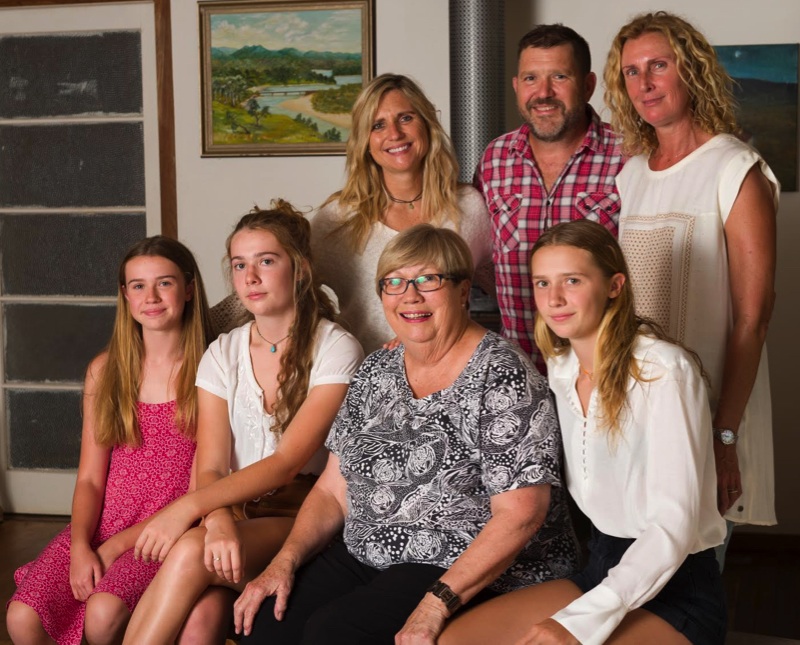
The Cromwell Family are all involved in making the business work. Standing from left: Greg’s sister, Karyn Cromwell Scarpa, Greg Cromwell and his wife Alison; seated, Bella, Aubrey, Greg’s mother Eleanor and Morley. Photo: Richard Johnson
While honeymooning with Alison in Tasmania, he came across Blundstone workboots for the first time and began making inquiries. Within a couple of years, they had exclusive rights to distribute Blundstones in Canada, and to retail RM Williams boots there as well. The Canadians love them and now the Cromwell’s three Australian Boot Company stores sell hundreds of thousand of pairs there. “It’s a big deal, and has allowed us to have some freedom to undertake new ventures here,” Greg says.
They also import and distribute a range of stylish coffee-making products, most notably the ROK Unplugged Espresso kit that allows aficionados to grind their own beans and make, sans electricity, a personalised cup of coffee, silently and with a warm glow of satisfaction.
They have their own coffee blend too, under the Top Shed label and are in the process of planting 100 coffee trees. With a large roasting machine already purchased, they are looking for a site to do their own processing through a new venture, The Coffee Agency. Beer-making is also in the pipeline, with a sort of “bake, roast and brew centre” envisaged for the property. A line of organic maple syrup is another possibility. (Enter the code Verandah 10 on the website to receive a 10% discount on the Espresso Unplugged coffee maker and grinder espressounplugged).
But none of this would be possible without the family showing a remarkable teamwork. Everyone pitches in, and with a grasshopper-minded dad whose personal motto is ‘fire, ready, aim,’ they need to be ready to hop to at a moment’s notice. “Alison and the girls make it all happen,” Greg says. “Without their capabilities and enthusiasm, this wouldn’t be possible.” Alison is the principal carer of the five horses on the property, including the latest acquisition, Bobbin. The three-year-old female brumby is a rescue horse from the Guy Fawkes Heritage Horse Association, yet to be ridden but settling in nicely.
The three teenage girls all fill significant roles in both the business and the hands-on side of the running of the property, including organising the farm’s beef and pork pop-up days, which attract up to 120 hungry guests.
“They set it all up, do all the selling, take visitors on tour, keep an eye on their children,” Greg says. “They’ve been empowered by their experience here.”
Morley, 16, has shown a talent for marketing, mastering Gumtree to advertise all the livestock, including the litters of kelpie puppies. She sold her first heifer when she was 10 and she has developed an expert eye for pricing, and for the formation and structure of cattle. Next she wants to upgrade the farm’s chicken breeding to include an incubator and a brooder box.
Eldest daughter Aubrey is off to UQ next year to study sports medicine, so someone will have to take over her duties keeping the animals’ records – births, deaths and “marriages”, tag numbers, treatments and so on. And the youngest, Bella, 14, feeds the dogs and helps train the horses.
The family’s team ethos has been founded in sport, which, says Greg, “is very much a part of our DNA. The farming’s a team sport. We’ve grown up being team sport players, and we’re a great team on the farm.” He discovered rugby in high school and has played it ever since, becoming a veteran at Bangalow, where he aims to reach the 200-match mark next season. Alison played netball competitively and is president of the Mullumbimby Netball Association. The girls all play the netball and basketball, representing Trinity Catholic College in Lismore and playing in other local leagues. But Aubrey’s flying the nest has been a wake-up call, prompting a plan to “zen” activities. “We realised we only have five years before all the girls are gone,” Greg says, so the plan for 2017 is to focus on family – “what the girls need us for” – rather than explore fresh avenues.
“We’ll concentrate on growing the core production lines,” says Morley, which is good news for the region’s foodies. The girls have spent most of their lives on farms and are not squeamish or sentimental about the animals’ fate. Morley says it would be worse if the cattle and pigs had not had a good life. “That would be sad but here there’s lots of space for them; they’re naturally fed, and handled constantly,” she says. Even the pigs are periodically allowed to roam freely in pasture.
Becoming farmers has been a “very, very steep learning curve”, says Alison. “We made every mistake in the book in the early days,” she says, including losing all their cattle in the bush – rescued by neighbouring “real farmers”, who have offered unfailing support.
Their friendly encouragement, the environment and Northern Co-operative Meat Company meatworks’ willingness to accept stock from small holders make the Northern Rivers an ideal place for the farming entrepreneur, Greg says.
But he knows his other business interests put him in a fortunate position – and acknowledges how tough it can be for many small farmers. The boot business is so successful the couple don’t have to work so hard, but they say it’s important for children to see their parents working – “it means they don’t take stuff for granted”.
And while none of the girls has plans to become a farmer, the earthy realism of life on the land has stood them in good stead for the world beyond Goonengerry’s green hills. They are all ambitious, confident, outgoing – and grateful for their good life.
As Aubrey says: “It means we know where our food comes from: knowing that, and the time and energy that has gone into it, makes it taste better.”
Photos: Digby Hildreth & Richard Johnson
Go to the Cromwell Farms website for more information: cromwellfarms
A Beef and Pork Pop-Up Day is planned at the farm on December 19 from 9am-12pm. To recieve a 10% discount, mention Verandah Magazine. (Enter the code Verandah 10 on the website to receive a 10% discount on the Espresso Unplugged coffee maker and grinder espressounplugged).
CROMWELL FARMS GROUP
Australia-Sheaffes Road
191 Sheaffes Rd, Goonengerry, NSW, 2482
PO Box 724 Mullumbimby, NSW, 2482
+61 2 6684 9400 (Farm House)
+61 2 6684 9457 (Top Shed)
+61 4477 55440 (Greg)
The post Black pigs and Blundstones – all part of the Cromwell Family Farm appeared first on .
]]>The post The Bentley Effect goes from strength to strength appeared first on .
]]>A near six year labour of love from local Director and Producer, Brendan Shoebridge, The Bentley Effect faithfully chronicles the campaign that led to the fateful showdown at the gates of Bentley, near Lismore.
The reception to the film has been extraordinary, receiving standing ovations at all of its screenings to date. “I was completely blown away by the audience reaction to The Bentley Effect’s World Premiere,” Brendan Shoebridge says. “I was completely unprepared for the standing ovation and honoured and humbled by such an emotional response to the film. It’s a tremendous relief to know that it’s ticked the boxes. The first priority was to ensure it was entertaining, but I didn’t want to make a film that people would simply watch either. I wanted to offer the audience an experience, the achat cialis en ligne next best thing to being there on the blockades. It also had to inspire hope and stay true to what played out.”
The film is not just the story of a social movement however. Woven through the commentary is a much broader discussion about the current political climate and the inability of our government to see beyond short term gain and corporate profits.
“It’s a remarkable time to release this documentary which is ultimately about standing up to corporate greed and general madness,” says Shoebridge, “especially in light of the protests boiling over in Dakota, the abhorrent Adani Carmichael Mine approvals now looming over our embattled Reef and places as unique as the Kimberly region – the third most pristine coastline in the world after the Arctic and Antarctic coast – all currently under fierce attack from fossil fuel interests – and all at a time when we know we must accelerate in the opposite direction. But with our State and Federal governments threatening legislation which would prevent environmental groups from taking legal action, whilst effectively removing the right of civilians to protest, the time really has come for people to take the power back into their own hands and show our political representatives what democracy is really about. I hope taking a trip back to Bentley through the eyes of the protestors will inspire The Bentley Effect to spread fast and ripple across the globe” says Shoebridge.
The film won the Byron Film Award at the Byron Bay International Film Festival recently and is touring select cinemas throughout the Northern Rivers before a wider distribution plan is hatched to send the film national and around the world.
To assist the film’s rollout, the production has partnered with Enova Energy -‐ Australia’s first community-‐owned renewable energy company. The Bentley Effect and Enova are also teaming up with COREM to bring Mullumbimby a celebration to remember on Saturday the 3rd of December 2016 at the Mullum Civic Hall with a combined movie screening, fundraising dinner and entertainment until midnight.
With a stellar line up of renowned popular Bentley entertainers joining this celebration, the evening is sure to be a highlight of the Mullumbimby entertainment calendar for 2016. Commencing at 6pm with dinner being catered by the organic COREM Café, the documentary will then screen, desert will follow and the celebration of the achievements of our community at Bentley will continue on the dance floor. We wish to bring the community connection that was the Bentley Blockade to the Mullum Civic Hall and acknowledge the incredible achievement of the northern rivers in stopping Coal Seam Gas. Enova will be present to promote their sign up campaign to switch local residents to Enova Energy and local beer brewers Stone & Wood are also supporting the event.
Tickets are $25 waged, $15 unwaged/concession, kids under 12 are free and dinner will be available for $15 a plate and for those flush with cash there will be a $50 Gold Pass ticket available (including dinner).
Proceeds of the evening will go towards the production of the documentary and COREM – Community.
For more information about the film you can visit the film’s website www.thebentleyeffect.com. Confirmed screenings can be found here: https://www.thebentleyeffect.com/screenings
December 1: NIMBIN BUSH THEATRE, Thursday 7.30PM, Tickets $20
December 3: MULLUMBIMBY CIVIC THEATRE, Saturday 7PM, Tickets $25/$15 Con
The post The Bentley Effect goes from strength to strength appeared first on .
]]>The post Native bee youth project wins major NRCF grant appeared first on .
]]>The region’s only philanthropic group, NRCF (Northern Rivers Community Foundation), announced its grants at its annual Grants Giving evening this week.
The NRCF was created 12 years ago by generous individuals within the community, and has distributed grants across 87 organisations and 211 projects – meeting social, cultural and environmental need. The 2016 announcements take the total amount committed by the Foundation to the community to over one million dollars.
The sought-after major annual grant of $25,000 was awarded to the Katia Native Bee Youth Employment Project from the Byron Bay Herb Nursery. The project aims to establish a native bee keeping business that provides employment opportunities for local indigenous youth and youth at disadvantage.
The Katia project will focus on manufacturing beehive boxes and farming native bees that can be sold or leased to the community and horticultural industry. The bees will be used for honey production as well as pollination of food crops and nut trees such as macadamias.
Participants will gain experience and skills in carpentry, native bee keeping and an understanding of the use of native bees in local indigenous cultural practices such as food and medicine production and implement making.
The Byron Bay Herb Nursery currently employs 23 people in their herb nursery, including six people with a disability. They also employ four young adults in their social enterprise area, which focuses on providing employment for youth at disadvantage through innovative projects such as composting.
The smallest grant of $1,000 went to Northern Rivers Wildlife for training 8 volunteers to handling venomous snakes.
NRCF’S Chair John Callanan said: “Between both these grant winners, another 20 projects further reflected the diversity of need within the community. We have found the innovation, creativity, articulation and sheer enthusiasm shared by all applicants to be heart-warming. We are seeing a new awareness and understanding of how to progress individual causes, be they from underprivileged groups, pop -up and continual arts seeding, access to health care, educational opportunities, life skills, law, justice and community connections – including social media hubs. Scan through the successful applicants for this year, you will be astonished.”
Grantees range from a Clown Doctors Program at Lismore Hospital, a Northern Rivers Indigenous Communities suicide prevention program, a deaf dance theatre workshop – to an e-space digital hub creating community reflections and swimming lessons for former refugee children.
2016/17 NRCF Grants
AUTISM SPECTRUM AUSTRALIAN (ASPECT)
Siblings Day 2017 – To provide a fun, supportive community day for the siblings of local children with autism.
BIALA SUPPORT SERVICES INC
An adult hydraulic change table for its Respite House.
BYRON YOUTH SERVICES
Nalia Dubay – A group of girls. To deliver an eight-week program for ‘at risk’ young women from Mullumbimby High School.
BYRON YOUTH THEATRE
Here Today: An original youth devised performance and workshop exploring the complex issues of youth suicide, early intervention and prevention – followed by panel discussion and community conversation event on youth suicide.
HART SERVICES
Learner Drivers’ Assistance Program – to assist people with barriers to obtain their probationary drivers licences and to accrue required driving hours and experience.
HEADSPACE LISMORE
“Spaced Out “@Headspace. Renovation and conversion of Headspace Lismore’s unused garage to a funky youth group room.
BYRON BAY HERB NURSERY
The Katia Native Bee Youth Employment Project – establishment of a native bee keeping business that provides employment opportunities for local Indigenous youth and youth at disadvantage.
LIFELINE NORTHERN RIVERS
Suicide prevention training for Northern Rivers Indigenous Communities. Delivering a culturally appropriate and tailored package for Aboriginal communities.
LISMORE SOUP KITCHEN
For the refurbishment of 4 units of transitional accommodation occupied by single males at 11 Bridge Street, North Lismore.
MID RICHMOND NEIGHBOURHOOD CENTRE
Crankfest Youth Festival: A celebration of Youth Culture and Art.
NORTHERN RIVERS LEGAL COMMUNITY CENTRE (NRLCC)
“Lets talk about Elder abuse.” To inform older members of our community about the prevalence of elder abuse, how to identify it and what to do about it.
NORTHERN RIVERS WILDLIFE CARERS
Training in handling venomous snakes – assistance with facilitation of the course for 8 NRWC volunteers.
RED INC
E-space digital hub: creating community connections. To engage people with autism spectrum disorder and other disabilities.
FERGUS & DELILAH PROJECT
Auspiced by SHAPING OUTCOMES Byron. Support Material for primary school teachers to teach the picture book Fergus and Delilah – a book that teaches young children to be more inclusive of children with a disability or developmental delay.
SHAPING OUTCOMES TWEED HEADS
The Parent Project – a seven-week course to assist parents/carers of children with a disability.
THE SHIFT PROJECT BYRON
SHIFT STITCHES – a small social enterprise program delivering training and work experience for disadvantaged women.
SPRUNG! INTEGRATED DANCE THEATRE
DANCING STORIES – A partnership between Sprung! and the Deaf Society North Coast to facilitate a deaf inclusive dance theatre workshop for deaf and non-deaf participants.
ST VINCENT DE PAUL
To kick start a swimming program for former refugee children at Goonellabah Sports Centre.
THE BUTTERY
For the Buttery’s free family counselling program.
THE HUMOUR FOUNDATION
For Lismore Hospital’s Clown Doctors Program.
UNITING CARE CASINO TRANSPORT TEAM
Transport to Resilience – transporting 10-12 clients in need of regular dialysis treatment to Lismore Base and St Vincent’s Hospital in Lismore.
WOMEN UP NORTH
LOVE BITES Program – a violence prevention program for young people.
www.nrcf.org.au
If you would like details on how to become involved and give to this independent philanthropic organisation go to https://www.nrcf.org.au/giving/why-give-to-the-nrcf/p/44
For further media information contact Rea Francis [email protected]
The post Native bee youth project wins major NRCF grant appeared first on .
]]>
